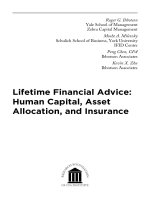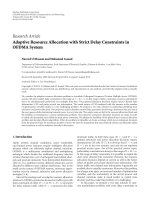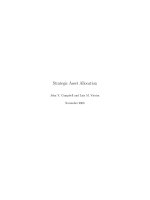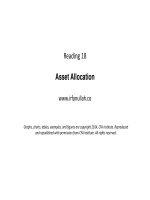Reading 20 asset allocation with real world constraints
Bạn đang xem bản rút gọn của tài liệu. Xem và tải ngay bản đầy đủ của tài liệu tại đây (239.13 KB, 3 trang )
Question #1 of 6
A pension fund is searching for an optimal portfolio by comparing the present value of
contributions and contribution risk as measured by a 95% confidence interval that
contributions will not exceed a given threshold. Which of the following portfolios
would be the most efficient under these criteria?
A) PV Contributions $60 million and Contribution risk $385 million.
B) PV Contributions $65 million and Contribution risk $392 million.
C) PV Contributions $69 million and Contribution risk $390 million.
Question #2 of 6
The Howarth School Foundation (HSF) has historically provided 30% of the annual
operating costs of running the Howarth Law school. Recent changes in government
funding mean that previously fully funded scholarships will now only be 40% funded
and that HSF must provide more support to the school. Based on this information,
HSF will most likely:
A) Increase the allocation to zero-coupon bonds to increase duration.
B) Increase the allocation to riskier timber and farmland to generate higher expected
return and cover the required outflows.
C) Decrease the allocation to private equity in order in increase the liquidity of the
portfolio.
Question #3 of 6
Goals based investing is most directly useful to counter:
A) representativeness.
B) loss aversion.
C) illusion of control.
Question #4 of 6
The strategic asset allocation, current allocation, and upper and lower policy limits for
a retirement portfolio are shown in the table below.
Asset Class
Fixed Income
Current Weight SAA Upper Limit Lower Limit
35%
40% 45%
35%
Domestic Equity 60%
50% 60%
40%
Real Estate
10% 15%
5%
5%
The portfolio manager takes a discretionary approach to tactical asset allocation. She
follows various indicators that she believes are useful in evaluating specific asset
classes. Her current observations and interpretations are:
Equity brokers have reported that margin borrowing levels increased
dramatically over the last two months and now sit at their highest levels for 15
months, a bearish sign.
Real estate indexes have started to rise suggesting the market may be 'heating
up', a bullish sign.
Indications from the federal reserve are that interest rates will rise several
times in the next 12 months, a clearly obvious sign.
Which of the following tactical allocation shifts is the manager most likely to make?
A) Increase the weighting to real estate.
B) Decrease the weighting to fixed income.
C) Increase the weighting to domestic equity.
Question #5 of 6
Kevin Collison has several different places where he has assets in which he manages
as separate accounts such as his checking account which he uses for short term cash
and emergency needs, his 401(k) account for retirement, and his children's college
fund. In his 401(k) he owns a small cap stock in a company which makes catheters to
be used in experimental cancer treatment in which the catheter is used to deliver
cancer killing drugs to hard to reach tumors in the body. The stock has recently taken
a downturn in price due to the FDA not approving their most recent catheter. As a
result of the downturn in price, Collison purchases more of the stock in hopes of
recouping his losses at some future time. Collison's management of his portfolio is
indicative of:
A) money illusion and fear of regret.
B) mental accounting and loss aversion.
C) asset allocation and pyramiding.
Question #6 of 6
Dan Vustings, 51, is a senior account executive at an advertising agency in San
Francisco. He currently has sufficient capital in his two investment portfolios to retire
in 14 years. His capital is evenly split between a taxable portfolio which he uses to
fund current consumption goals and a tax-deferred retirement account. Vustings
received advice from an investment manager last year who suggested the following
asset allocation:
High-yield bonds 15%
High dividend yield equities 50%
High growth equities 35%
Vustings has the same allocation in both the taxable and the retirement account.
Which of the following allocations would be most likely to improve the efficiency of the
portfolios, ignoring rebalancing or withdrawal penalties?
A) Increase the allocation to high-dividend yield equities in the taxable account, and
increase the allocation to high growth equities in the retirement account.
B) Increase the allocation to high-yield bonds in the taxable account, and increase the
allocation to high growth equities in the retirement account.
C) Increase the allocation to high-yield bonds in the retirement account, and increase
the allocation to high growth equity investments in the taxable account.









